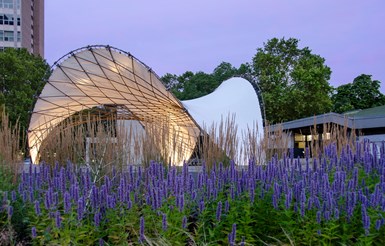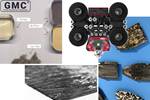Biocomposite for mobile architecture, low load-bearing applications
The German Institutes of Textile and Fiber Research and partners have developed a biocomposite well suited for support profiles and connecting nodes in construction applications.

The LightPro Shell Pavilion — produced by DITF and CG-TECH. Photo Credit: BioMat/ITKE, University of Stuttgart
The German Institutes of Textile and Fiber Research (DITF, Denkendorf) have developed a sustainable biocomposite material for support profiles and connecting nodes. The ultralight components are the result of a joint project between partners from research and industry, funded by the German Federal Ministry of Food and Agriculture. In the future, the components can be used in the field of mobile architecture and in pavilions and architecture with low load-bearing capacity.
The DITF had the task of selecting suitable materials for the biocomposite and developing manufacturing processes. In order to achieve the highest possible organic content, hemp and flax fibers and a resin system based on epoxidized linseed oil were used. These natural resources were used in both pultrusion and hotpressing processes.
Processing natural fibers into high-performance products is challenging because they are thicker, more uneven, wetter and also more sensitive than high-performance fibers made of glass, carbon or aramid. To date, natural fibers have been predominantly pultruded using petroleum-based resins or resins with a very low bio-content. The resulting composites did not achieve sufficient fiber-matrix adhesion, which is why the mechanical properties were unsatisfactory. At the DITF, these material- and process-related problems are said to be largely solved. For example, the pre-drying of the natural fiber rovings in pultrusion was a decisive solution. What was successful on a laboratory scale at the DITF could also be implemented on an industrial scale.
Practical tests have shown that the developed biocomposite material is suitable for a range of architectural applications, DITF says. Compared to fiberglass plastics, biocomposites do not splinter in a crash. They are also a sustainable building material. They consume less energy in their production and sequester a large amount of carbon in the long term. Due to their low density, they weigh little and are, therefore, suitable for lightweight construction applications. The aim of lightweight construction is to save raw materials, energy and costs. According to the DITF, use of biocomposites offers the construction industry potential for treading resource-saving paths.
Related Content
-
Materials & Processes: Fibers for composites
The structural properties of composite materials are derived primarily from the fiber reinforcement. Fiber types, their manufacture, their uses and the end-market applications in which they find most use are described.
-
Materials & Processes: Composites fibers and resins
Compared to legacy materials like steel, aluminum, iron and titanium, composites are still coming of age, and only just now are being better understood by design and manufacturing engineers. However, composites’ physical properties — combined with unbeatable light weight — make them undeniably attractive.
-
Natural fiber composites: Growing to fit sustainability needs
Led by global and industry-wide sustainability goals, commercial interest in flax and hemp fiber-reinforced composites grows into higher-performance, higher-volume applications.













